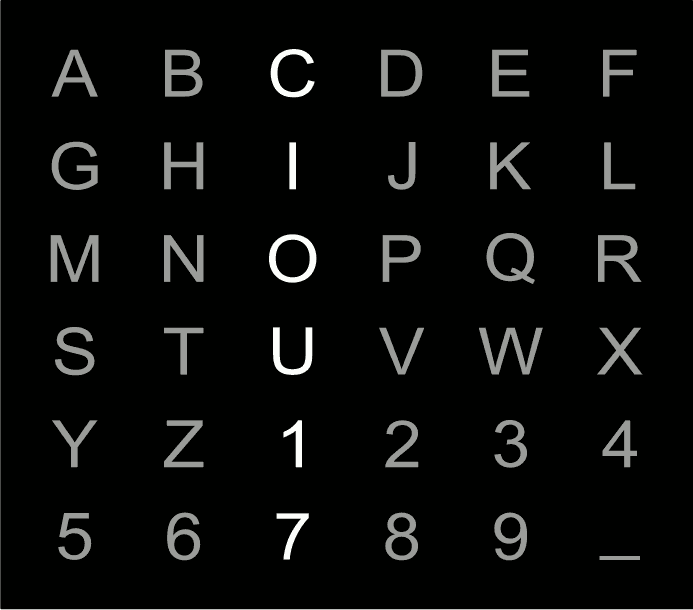This dataset is described in:
Please cite this publication when referencing this material, and also include the standard citation for PhysioNet:
Experimental Protocol
This dataset — created and contributed by Luca Citi, Riccardo Poli, and Caterina Cinel — was generated as part of a study aimed at identifying the factors limiting the performance of brain-computer interfaces (BCIs) based on event-related potentials (ERPs), in order to improve the transfer rate and the usability of these interfaces.
 In this study, each participant was asked to spell a total of 20 characters
using a traditional matrix speller (shown at left). Each record in the
dataset contains the signals, triggers and annotations corresponding to a
single run, i.e. the spelling of a single character. Target characters were
randomly chosen before the beginning of the run. Each row and column of the
standard 6x6 matrix of characters was randomly intensified without replacement
for 100 ms with a gap of 50 ms, leading to a stimulus onset asynchrony (SOA) of
150 ms. During a run, each row and column flashed approximately 20
times. During that period, subjects were asked to focus on the target character
and to mentally count the number of times it was highlighted. From subject 03
onwards, subjects were asked to report their final count at the end of the run.
In this study, each participant was asked to spell a total of 20 characters
using a traditional matrix speller (shown at left). Each record in the
dataset contains the signals, triggers and annotations corresponding to a
single run, i.e. the spelling of a single character. Target characters were
randomly chosen before the beginning of the run. Each row and column of the
standard 6x6 matrix of characters was randomly intensified without replacement
for 100 ms with a gap of 50 ms, leading to a stimulus onset asynchrony (SOA) of
150 ms. During a run, each row and column flashed approximately 20
times. During that period, subjects were asked to focus on the target character
and to mentally count the number of times it was highlighted. From subject 03
onwards, subjects were asked to report their final count at the end of the run.
During the recordings, subjects were seated comfortably with the neck supported by a C-shaped inflatable travel pillow to reduce muscular artefacts. The eyes were at approximately 80 cm from a 22-inch LCD screen with 60 Hz refresh rate. Data were collected using a BioSemi ActiveTwo EEG system sampled at 2048 Hz. The signals recorded comprise 64 EEG electrodes (locations are specified here), two earlobes (EARL and EARR) for referencing, and vertical and horizontal electrooculograms (VEOGL, VEOGR, HEOGL, and HEOGR) for artefact removal. The signals are referenced to the CMS electrode (see BioSemi's FAQ ). As this mode does not provide the full common mode rejection ratio (CMRR), the signals should be re-referenced via software (e.g., with respect to the average of EARL and EARR) to achieve the full CMRR and improve the signal-to-noise ratio.
Data format
The data are provided here in EDF+ format (containing the signals and an annotation channel). For use with PhysioToolkit software, rdedfann was used to generate a separate PhysioBank-compatible annotation file (with the suffix .event) for each record. The .event files and the EDF annotation channels in the corresponding EDF+ files contain identical data. In each record, annotations have the following structure:
0:01.588 3252 #TgtP_RC01_SOA63
0:02.091 4282 #start
0:05.535 11336 MNOPQR
0:05.685 11643 STUVWX
...
0:25.178 51565 FLRX4_
0:30.122 61689 #counted22of22
0:30.375 62207 #end
The first annotation reports the target character (“P” in the example), the name of the run (RC01) and information about the duration of the stimuli timing (stimuli are on for 6 refresh cycles, i.e. 100 ms, and off for 3, i.e. 50 ms). The second annotation marks the beginning of the run while the last one its end. In the example, the penultimate annotation reports the number of target flashes counted by the subject and the actual number displayed. All other annotations report the timing of each intensification and the set of characters (in a row or column) being intensified.
Name Last modified Size Description
Parent Directory -
DOI 2015-09-21 12:21 20
MD5SUMS 2014-01-29 17:59 25K
s01/ 2014-01-30 03:37 -
s02/ 2014-01-30 03:37 -
s03/ 2014-01-30 03:37 -
s04/ 2014-01-30 03:37 -
s05/ 2014-01-30 03:36 -
s06/ 2014-01-30 03:37 -
s07/ 2014-01-30 03:36 -
s08/ 2014-01-30 03:36 -
s09/ 2014-01-30 03:37 -
s10/ 2014-01-30 03:37 -
s11/ 2014-01-30 03:37 -
s12/ 2014-01-30 03:37 -
speller.png 2014-01-29 17:59 8.3K
ANNOTATORS 2014-01-29 17:59 24 list of annotators
RECORDS 2014-01-29 17:59 3.1K list of record names
|
If you would like help understanding, using, or downloading content, please see our Frequently Asked Questions. If you have any comments, feedback, or particular questions regarding this page, please send them to the webmaster. Comments and issues can also be raised on PhysioNet's GitHub page. Updated Friday, 28 October 2016 at 16:58 EDT |
PhysioNet is supported by the National Institute of General Medical Sciences (NIGMS) and the National Institute of Biomedical Imaging and Bioengineering (NIBIB) under NIH grant number 2R01GM104987-09.
|